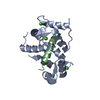+ Open data
Open data
- Basic information
Basic information
| Entry | Database: PDB / ID: 7b1g | ||||||
|---|---|---|---|---|---|---|---|
| Title | TRPC4 in complex with Calmodulin | ||||||
 Components Components |
| ||||||
 Keywords Keywords | TRANSPORT PROTEIN / ION CHANNEL / TRPC4 / COMPLEX / MEMBRANE PROTEIN / CALMODULIN | ||||||
| Function / homology |  Function and homology information Function and homology informationCaMK IV-mediated phosphorylation of CREB / Cam-PDE 1 activation / CREB1 phosphorylation through the activation of CaMKII/CaMKK/CaMKIV cascasde / Glycogen breakdown (glycogenolysis) / Activation of RAC1 downstream of NMDARs / Sodium/Calcium exchangers / Activation of Ca-permeable Kainate Receptor / Synthesis of IP3 and IP4 in the cytosol / CLEC7A (Dectin-1) induces NFAT activation / RHO GTPases activate PAKs ...CaMK IV-mediated phosphorylation of CREB / Cam-PDE 1 activation / CREB1 phosphorylation through the activation of CaMKII/CaMKK/CaMKIV cascasde / Glycogen breakdown (glycogenolysis) / Activation of RAC1 downstream of NMDARs / Sodium/Calcium exchangers / Activation of Ca-permeable Kainate Receptor / Synthesis of IP3 and IP4 in the cytosol / CLEC7A (Dectin-1) induces NFAT activation / RHO GTPases activate PAKs / Calmodulin induced events / Inactivation, recovery and regulation of the phototransduction cascade / Tetrahydrobiopterin (BH4) synthesis, recycling, salvage and regulation / eNOS activation / Reduction of cytosolic Ca++ levels / Unblocking of NMDA receptors, glutamate binding and activation / Calcineurin activates NFAT / Ion transport by P-type ATPases / Protein methylation / RAF activation / VEGFR2 mediated vascular permeability / RAS processing / Ca2+ pathway / RHO GTPases activate IQGAPs / Extra-nuclear estrogen signaling / FCERI mediated Ca+2 mobilization / RAF/MAP kinase cascade / PKA activation / store-operated calcium channel activity / Smooth Muscle Contraction / Platelet degranulation / High laminar flow shear stress activates signaling by PIEZO1 and PECAM1:CDH5:KDR in endothelial cells / Stimuli-sensing channels / inositol 1,4,5 trisphosphate binding / establishment of protein localization to mitochondrial membrane / Ion homeostasis / type 3 metabotropic glutamate receptor binding / cation channel complex / response to corticosterone / negative regulation of ryanodine-sensitive calcium-release channel activity / organelle localization by membrane tethering / mitochondrion-endoplasmic reticulum membrane tethering / autophagosome membrane docking / regulation of cardiac muscle cell action potential / presynaptic endocytosis / nitric-oxide synthase binding / regulation of synaptic vesicle exocytosis / calcineurin-mediated signaling / adenylate cyclase binding / regulation of ryanodine-sensitive calcium-release channel activity / protein phosphatase activator activity / monoatomic cation transport / detection of calcium ion / catalytic complex / regulation of synaptic vesicle endocytosis / regulation of cardiac muscle contraction / regulation of cytosolic calcium ion concentration / postsynaptic cytosol / monoatomic cation channel activity / cellular response to interferon-beta / phosphatidylinositol 3-kinase binding / calcium channel inhibitor activity / presynaptic cytosol / regulation of release of sequestered calcium ion into cytosol by sarcoplasmic reticulum / titin binding / sperm midpiece / voltage-gated potassium channel complex / calcium channel complex / regulation of heart rate / calyx of Held / response to amphetamine / adenylate cyclase activator activity / sarcomere / nitric-oxide synthase regulator activity / protein serine/threonine kinase activator activity / regulation of cytokinesis / spindle microtubule / positive regulation of receptor signaling pathway via JAK-STAT / mitochondrial membrane / calcium ion transmembrane transport / cellular response to type II interferon / G2/M transition of mitotic cell cycle / Schaffer collateral - CA1 synapse / spindle pole / calcium-dependent protein binding / synaptic vesicle membrane / myelin sheath / growth cone / transmembrane transporter binding / protein domain specific binding / calcium ion binding / centrosome / protein kinase binding / nucleoplasm / plasma membrane / cytoplasm / cytosol Similarity search - Function | ||||||
| Biological species |   | ||||||
| Method | ELECTRON MICROSCOPY / single particle reconstruction / cryo EM / Resolution: 3.6 Å | ||||||
 Authors Authors | Vinayagam, D. / Quentin, D. / Sistel, O. / Merino, F. / Stabrin, M. / Hofnagel, O. / Ledeboer, M.W. / Malojcic, G. / Raunser, S. | ||||||
| Funding support |  Germany, 1items Germany, 1items
| ||||||
 Citation Citation |  Journal: Elife / Year: 2020 Journal: Elife / Year: 2020Title: Structural basis of TRPC4 regulation by calmodulin and pharmacological agents. Authors: Deivanayagabarathy Vinayagam / Dennis Quentin / Jing Yu-Strzelczyk / Oleg Sitsel / Felipe Merino / Markus Stabrin / Oliver Hofnagel / Maolin Yu / Mark W Ledeboer / Georg Nagel / Goran ...Authors: Deivanayagabarathy Vinayagam / Dennis Quentin / Jing Yu-Strzelczyk / Oleg Sitsel / Felipe Merino / Markus Stabrin / Oliver Hofnagel / Maolin Yu / Mark W Ledeboer / Georg Nagel / Goran Malojcic / Stefan Raunser /   Abstract: Canonical transient receptor potential channels (TRPC) are involved in receptor-operated and/or store-operated Ca signaling. Inhibition of TRPCs by small molecules was shown to be promising in ...Canonical transient receptor potential channels (TRPC) are involved in receptor-operated and/or store-operated Ca signaling. Inhibition of TRPCs by small molecules was shown to be promising in treating renal diseases. In cells, the channels are regulated by calmodulin (CaM). Molecular details of both CaM and drug binding have remained elusive so far. Here, we report structures of TRPC4 in complex with three pyridazinone-based inhibitors and CaM. The structures reveal that all the inhibitors bind to the same cavity of the voltage-sensing-like domain and allow us to describe how structural changes from the ligand-binding site can be transmitted to the central ion-conducting pore of TRPC4. CaM binds to the rib helix of TRPC4, which results in the ordering of a previously disordered region, fixing the channel in its closed conformation. This represents a novel CaM-induced regulatory mechanism of canonical TRP channels. | ||||||
| History |
|
- Structure visualization
Structure visualization
| Movie |
 Movie viewer Movie viewer |
|---|---|
| Structure viewer | Molecule:  Molmil Molmil Jmol/JSmol Jmol/JSmol |
- Downloads & links
Downloads & links
- Download
Download
| PDBx/mmCIF format |  7b1g.cif.gz 7b1g.cif.gz | 501 KB | Display |  PDBx/mmCIF format PDBx/mmCIF format |
|---|---|---|---|---|
| PDB format |  pdb7b1g.ent.gz pdb7b1g.ent.gz | 391.8 KB | Display |  PDB format PDB format |
| PDBx/mmJSON format |  7b1g.json.gz 7b1g.json.gz | Tree view |  PDBx/mmJSON format PDBx/mmJSON format | |
| Others |  Other downloads Other downloads |
-Validation report
| Summary document |  7b1g_validation.pdf.gz 7b1g_validation.pdf.gz | 1 MB | Display |  wwPDB validaton report wwPDB validaton report |
|---|---|---|---|---|
| Full document |  7b1g_full_validation.pdf.gz 7b1g_full_validation.pdf.gz | 1.1 MB | Display | |
| Data in XML |  7b1g_validation.xml.gz 7b1g_validation.xml.gz | 76.7 KB | Display | |
| Data in CIF |  7b1g_validation.cif.gz 7b1g_validation.cif.gz | 113.1 KB | Display | |
| Arichive directory |  https://data.pdbj.org/pub/pdb/validation_reports/b1/7b1g https://data.pdbj.org/pub/pdb/validation_reports/b1/7b1g ftp://data.pdbj.org/pub/pdb/validation_reports/b1/7b1g ftp://data.pdbj.org/pub/pdb/validation_reports/b1/7b1g | HTTPS FTP |
-Related structure data
| Related structure data |  11985MC  7b05C  7b0jC  7b0sC  7b16C C: citing same article ( M: map data used to model this data |
|---|---|
| Similar structure data |
- Links
Links
- Assembly
Assembly
| Deposited unit | 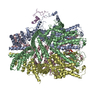
|
|---|---|
| 1 |
|
- Components
Components
| #1: Protein | Mass: 105204.641 Da / Num. of mol.: 4 Source method: isolated from a genetically manipulated source Source: (gene. exp.)   Homo sapiens (human) / References: UniProt: U3N7D8 Homo sapiens (human) / References: UniProt: U3N7D8#2: Protein | | Mass: 16852.545 Da / Num. of mol.: 1 Source method: isolated from a genetically manipulated source Source: (gene. exp.)   #3: Chemical | ChemComp-CA / #4: Chemical | ChemComp-44E / ( Has ligand of interest | N | |
|---|
-Experimental details
-Experiment
| Experiment | Method: ELECTRON MICROSCOPY |
|---|---|
| EM experiment | Aggregation state: PARTICLE / 3D reconstruction method: single particle reconstruction |
- Sample preparation
Sample preparation
| Component |
| ||||||||||||||||||||||||||||
|---|---|---|---|---|---|---|---|---|---|---|---|---|---|---|---|---|---|---|---|---|---|---|---|---|---|---|---|---|---|
| Molecular weight | Value: 0.126 MDa / Experimental value: NO | ||||||||||||||||||||||||||||
| Source (natural) |
| ||||||||||||||||||||||||||||
| Source (recombinant) |
| ||||||||||||||||||||||||||||
| Buffer solution | pH: 7.4 | ||||||||||||||||||||||||||||
| Buffer component |
| ||||||||||||||||||||||||||||
| Specimen | Conc.: 0.35 mg/ml / Embedding applied: NO / Shadowing applied: NO / Staining applied: NO / Vitrification applied: YES | ||||||||||||||||||||||||||||
| Specimen support | Grid material: COPPER / Grid type: Quantifoil R2/1 | ||||||||||||||||||||||||||||
| Vitrification | Instrument: FEI VITROBOT MARK IV / Cryogen name: ETHANE / Humidity: 95 % / Chamber temperature: 277 K |
- Electron microscopy imaging
Electron microscopy imaging
| Experimental equipment |  Model: Titan Krios / Image courtesy: FEI Company |
|---|---|
| Microscopy | Model: FEI TITAN KRIOS |
| Electron gun | Electron source:  FIELD EMISSION GUN / Accelerating voltage: 300 kV / Illumination mode: FLOOD BEAM FIELD EMISSION GUN / Accelerating voltage: 300 kV / Illumination mode: FLOOD BEAM |
| Electron lens | Mode: BRIGHT FIELD / Nominal magnification: 130000 X / Calibrated magnification: 59000 X / Nominal defocus max: 2800 nm / Nominal defocus min: 1500 nm / Cs: 0.001 mm / C2 aperture diameter: 70 µm / Alignment procedure: ZEMLIN TABLEAU |
| Specimen holder | Cryogen: NITROGEN / Specimen holder model: FEI TITAN KRIOS AUTOGRID HOLDER / Temperature (max): 190 K / Temperature (min): 160 K |
| Image recording | Average exposure time: 10 sec. / Electron dose: 88.52 e/Å2 / Detector mode: COUNTING / Film or detector model: GATAN K2 QUANTUM (4k x 4k) / Num. of grids imaged: 1 / Num. of real images: 7972 |
| EM imaging optics | Energyfilter name: GIF Quantum LS / Energyfilter slit width: 20 eV Spherical aberration corrector: Cs corrector first generation |
| Image scans | Sampling size: 5 µm / Width: 3838 / Height: 3710 / Movie frames/image: 80 / Used frames/image: 1-80 |
- Processing
Processing
| Software |
| |||||||||||||||||||||||||||||||||||||||||||||
|---|---|---|---|---|---|---|---|---|---|---|---|---|---|---|---|---|---|---|---|---|---|---|---|---|---|---|---|---|---|---|---|---|---|---|---|---|---|---|---|---|---|---|---|---|---|---|
| EM software |
| |||||||||||||||||||||||||||||||||||||||||||||
| CTF correction | Type: PHASE FLIPPING ONLY | |||||||||||||||||||||||||||||||||||||||||||||
| Particle selection | Num. of particles selected: 678331 | |||||||||||||||||||||||||||||||||||||||||||||
| Symmetry | Point symmetry: C1 (asymmetric) | |||||||||||||||||||||||||||||||||||||||||||||
| 3D reconstruction | Resolution: 3.6 Å / Resolution method: FSC 0.143 CUT-OFF / Num. of particles: 160829 / Algorithm: FOURIER SPACE / Num. of class averages: 4 / Symmetry type: POINT | |||||||||||||||||||||||||||||||||||||||||||||
| Atomic model building | B value: 58.04 / Protocol: FLEXIBLE FIT / Space: REAL / Target criteria: Correlation coefficient | |||||||||||||||||||||||||||||||||||||||||||||
| Atomic model building |
| |||||||||||||||||||||||||||||||||||||||||||||
| Refinement | Cross valid method: NONE Stereochemistry target values: GeoStd + Monomer Library + CDL v1.2 | |||||||||||||||||||||||||||||||||||||||||||||
| Displacement parameters | Biso mean: 57.92 Å2 | |||||||||||||||||||||||||||||||||||||||||||||
| Refine LS restraints |
|
 Movie
Movie Controller
Controller







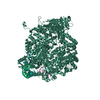
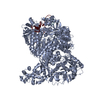

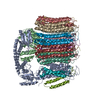



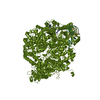
 PDBj
PDBj

















